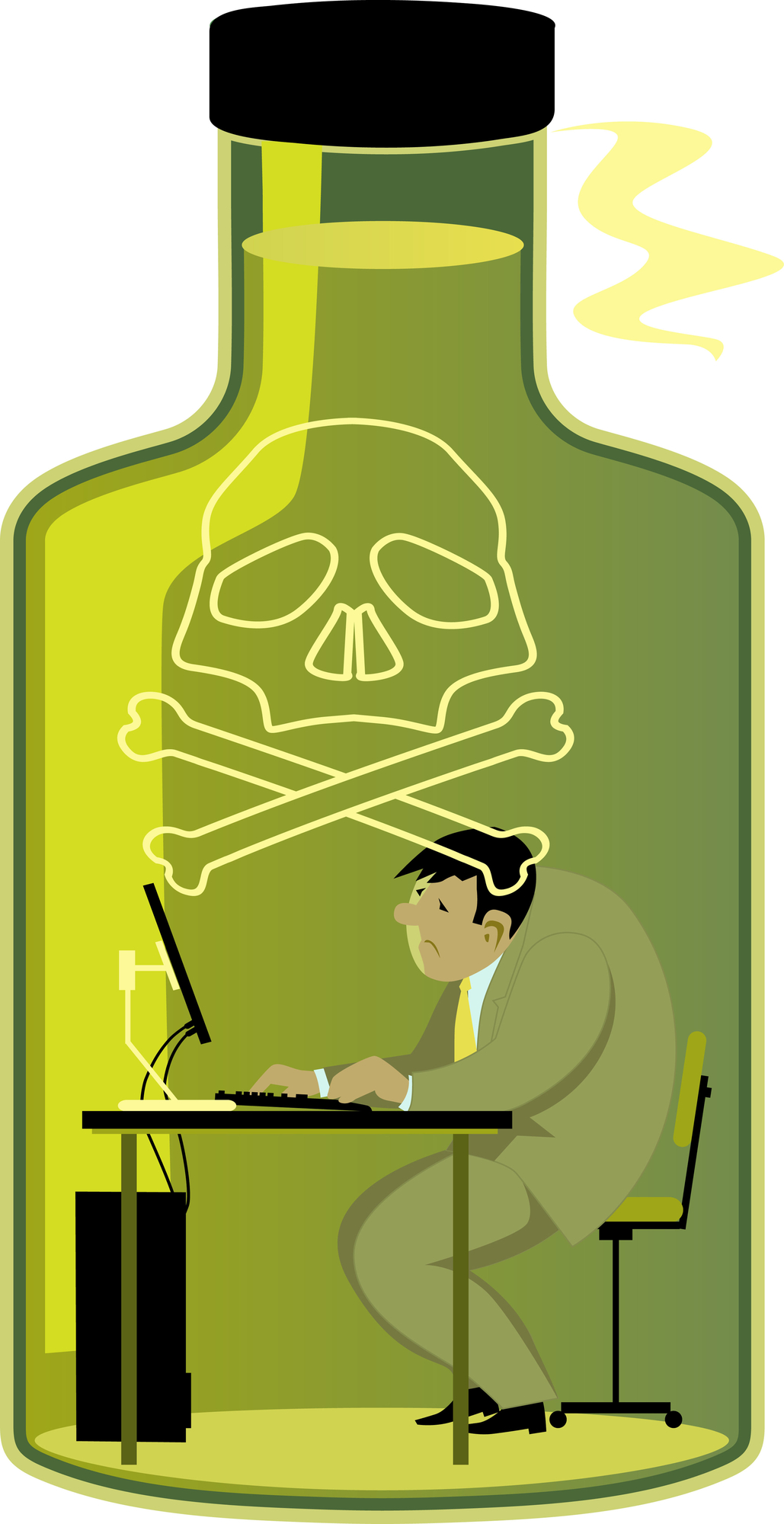The Toxic Work Environments episode of our TeamBonding podcast Team Building Saves the World confronts the all too well-known topic of toxic workplaces, how to tell if you’re in one, and how to handle it. Rich Rininsland talks about increasingly toxic work environments with expert Nicole L. Turner, CEO of Nicole L. Turner Consulting and The Culture Pro™. Listen to the Toxic Work Environment podcast for Rich and Nicole’s conversation about navigating toxic work environments and making the best choices for your personal success.
What is a Toxic Work Environment?
 A toxic work environment can be defined as any work setting where the atmosphere negatively impacts employees and causes disruption to their career growth. If you are in a toxic work environment, it is essential to identify it early on so you can take the proper steps to mitigate any damage it may cause to your mental health or workplace development. Here are 10 signs that your work environment or workplace might be toxic:
A toxic work environment can be defined as any work setting where the atmosphere negatively impacts employees and causes disruption to their career growth. If you are in a toxic work environment, it is essential to identify it early on so you can take the proper steps to mitigate any damage it may cause to your mental health or workplace development. Here are 10 signs that your work environment or workplace might be toxic:
10 Signs of a Toxic Workplace
1. Your input isn’t valued
The first sign that your workplace is toxic is that when you speak up, managers and co-workers do not listen. Employees that deal with problems day-to-day are a reliable source for coming up with solutions, so if your input is not being treated as valuable it is likely a sign that management doesn’t prioritize their employees. Companies invest in people as much as they do any other asset, and by dismissing the input of team members they are wasting priceless information. An organization that doesn’t value its employees will allow a toxic environment to flourish.
2. Gossip and rumors run rampant
If your office often feels more like the gossip-filled halls of high school than a professional workplace, this is a definite sign of toxic behaviors. Rampant rumor spreading and gossiping indicates a leadership team that is indifferent to the wellbeing and privacy of their employees. These behaviors are immature and unacceptable.
3. Bullying
In the workplace, bullying can take forms that don’t always look how it is typically portrayed. Although bullying can include overt verbal or physical abuse, it can also take covert forms such as nonverbal or psychological abuse. Enduring these abuses can be very harmful to an employee’s health and wellbeing and should never be tolerated in any environment. Toxic environments breed an atmosphere that permits bullies to prosper because they allow bullying behavior to go unchecked.
4. Unfair policies and unequal enforcement of them
Rules that seem to have no basis or rules that only apply selectively to certain employees usually mean that management plays favorites. Environments that don’t set the same standard of conduct for everyone enable some team members to exercise special privileges that are not accessible to others. Privileges could take many forms, from excusing tardiness to inappropriate behaviors, to more serious misconduct.
5. Narcissistic leadership
Leaders that exhibit narcissistic tendencies are far from an anomaly, unfortunately. These tendencies can manifest themselves in self-interest, lack of empathy, lack of self-awareness, or any of the behaviors included on this list. It can be difficult to reason or even coexist with a narcissist, resulting in high turnover due to employees’ inability to cope with this type of leader.
6. Communication issues and lack of transparency
Transparency has been a big buzzword recently, and for good reason. Communication and honesty are essential for organizations to maintain the mutual trust that is necessary for a successful workplace environment. When these core elements are missing, a team is operating as separate disjointed pieces rather than as a cohesive unit.
7. Lack of work-life balance
The importance of work-life balance has increased throughout the Covid-19 pandemic and is more significant than ever now that some workers may be going back into the office instead of working from home. As the value of work-life balance rises, the awareness of having a poor balance becomes more apparent. In this climate, it is intolerable to work for a company that requires employees to sacrifice their well-being for the sake of their job. A company that doesn’t allow employees to have a work-life balance is guilty of enforcing a toxic environment.
8. Low morale
Although we are all entitled to being in a slump at times during a particularly stressful work week, organizations that maintain low morale amongst their team members long-term are usually also maintaining a toxic environment. Low morale tends to occur when employees do not feel financially or professionally valued, feel disconnected from their team, work under poor leadership, suffer abuse or harassment at work, for example.
9. Not having enough people to do the work and high levels of burnout
 Burnout is usually a symptom of a lack of work-life balance, which can happen when companies refuse to hire new members and instead force extra workload on their existing employees. This scenario became prevalent during the pandemic, as companies have been forced to lay off workers but must still maintain the same level of productivity. Forcing team members to make up for work that should be done by another worker diminishes their work-life balance and can quickly lead to burnout. High levels of burnout almost always indicate the presence of a toxic work environment.
Burnout is usually a symptom of a lack of work-life balance, which can happen when companies refuse to hire new members and instead force extra workload on their existing employees. This scenario became prevalent during the pandemic, as companies have been forced to lay off workers but must still maintain the same level of productivity. Forcing team members to make up for work that should be done by another worker diminishes their work-life balance and can quickly lead to burnout. High levels of burnout almost always indicate the presence of a toxic work environment.
10. Lack of empathy and compassion from leadership – putting work deadlines first over your emotional well-being
Leaders that exhibit a lack of empathy or compassion are usually also narcissists, which prevents them from prioritizing their employees. These types of leaders will often require that their team members designate work as a top priority, diminishing the ability for them to achieve work-life balance, and possibly resulting in burnout. Any leader that forces employees to choose between their job and their health is poisoning their work environment.
How Should You Handle a Toxic Work Environment?
If you feel like you can have a conversation with your leadership about the issues you’re having and not face retaliation, have that conversation. Approach leadership candidly and explain your experience to them. This should be a conversation with the intended end goal being a mutually beneficial solution.
If you are a leader and sense toxicity developing in your team’s environment, look to find a solution. If the problem isn’t addressed you could ultimately lose top talent and have less engaged and motivated employees. Be approachable, be understanding, and be aware of what is going on in the office. Activities such as Remote Team DNA and Breaking Barriers can help team members understand their strengths and weaknesses, make better decisions, avoid unnecessary friction, and increase productivity. Team building activities open doors to learning and understanding more about each other, which carries over to the office.
“So I tell them first, you know, your mental and emotional health is essential. If there’s something that you can go to your boss and say: Hey, I’m having issues with this… give them the opportunity to meet you in the middle if they can make change happen.” – Nicole L. Turner
If there is no solution in sight, start working on an exit plan.
If the conversation does not end positively or could not occur at all, plan how to remove yourself from this environment. Although it may be tempting to quit immediately when you hate your job, make sure that quitting will not put you into an even worse position. Nicole’s advice is to plan ahead, and not to quit before you have secured a new job or have sufficient savings to sustain yourself.
“And when you’re trying to make change happen rapidly out of desperation, survival mode, you tend to not go to something that’s even better. It’s different, but not better. So I always recommend start talking, talk to your boss first. If that doesn’t work, start working your exit plan. And sometimes our exit plan may take six months to a year, but start working it so you can get to an environment that’s better for you mentally and emotionally.”
She also advises that unsatisfied team members take ample time crafting and implementing this exit plan. The plan may span months or even years, “but it’s important to work on to get into a better work environment that is better for your mental and emotional health.”














